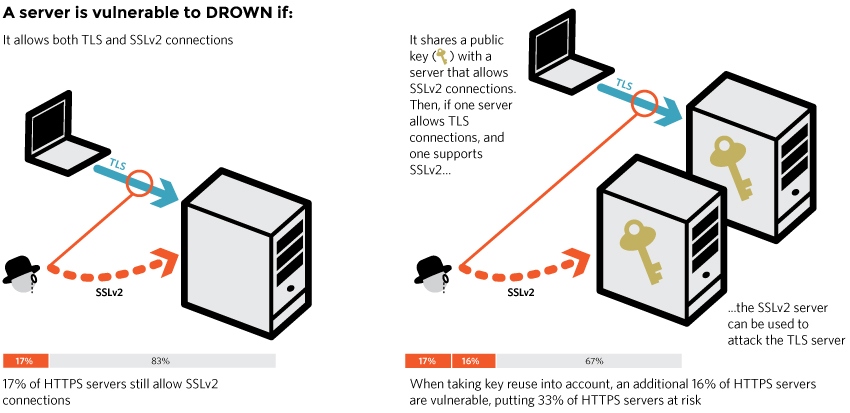DROWN attack on OpenSSL posted March 2016
There is a new attack on OpenSSL. It's called DROWN.

Two problems:
-
in OpenSSL versions prior to January of this year, SSLv2 is by default not disabled. They thought that removing all the SSLv2 cipher suites from the default cipher string (back in 2010) would work but... nope. Even if not advertised in the serverHello, you can still do a handshake with whatever SSLv2 cipher you want. Another way of completely disabling SSLv2 exists, but it's recent and it is not the default option.
- A padding oracle attack still exists in SSLv2. This is because of the export cipher suites. These weak ciphers and key lengths the USA government was forcing on OpenSSL so that people overseas could use it. So, these export cipher suites, nowadays they are bruteforce-able. It takes a few hours though, and a few hundred dollars, so no easy active MITM. It's a rather passive attack.
This is a cross-protocol attack. This means that you are a MITM, but you leave the client doing his thing on a TLS 1.2 or whatever SSLv3+ protocol. In the mean time though, you use the SSLv2 connection as an Oracle to recover the premaster-key (and thus the session key that is derived from it).

Three things:
-
The attack works on RSA handshakes. In the handshake (precisely in the clientKeyExchange) the client will encrypt his premaster-key with the server's RSA public key, this is what the attack decrypts. The server doesn't support RSA handshakes? You'll have to attack another server.
-
The server doesn't have to work with SSLv2. If another server (could even be a mail server) sharing the same RSA key and supporting SSLv2 exists, then you can use it as your oracle during the attack! Practical much?
- To use the oracle, you need to first transform the RSA encrypted premaster-key into a valid SSLv2 RSA encrypted master-key. It is quite different, because of protocol differences, and you need to use quite a few tricks (trimmers!). It doesn't work all the time, around 1 out of 1,000 RSA encrypted premaster-key can be decrypted. This is often more than enough to steal the cookies and have consequences. If you're targeting a specific individual it can take time though, so to speed up these 1,000 handshakes just inject some javascript in a non-https webpage!
That's pretty much everything. I'm still going through the paper, trying to understand the math. There is a tool here to test your website. Another way of doing this (especially for internal servers) is to get an openssl version prior to january this year and do that on all of your subdomains/domains: openssl s_client -ssl2 -connect www.cryptologie.net:443


Comments
leave a comment...